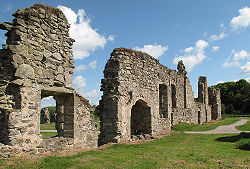
Grace Dieu Priory
Encyclopedia


Priory
A priory is a house of men or women under religious vows that is headed by a prior or prioress. Priories may be houses of mendicant friars or religious sisters , or monasteries of monks or nuns .The Benedictines and their offshoots , the Premonstratensians, and the...
near Thringstone
Thringstone
Thringstone is a village in north-west Leicestershire, England about north of Coalville. It lies within the area of the English National Forest and is part of the East Midlands region....
in Leicestershire
Leicestershire
Leicestershire is a landlocked county in the English Midlands. It takes its name from the heavily populated City of Leicester, traditionally its administrative centre, although the City of Leicester unitary authority is today administered separately from the rest of Leicestershire...
, England. It was founded around 1235-1241 by Roesia de Verdon and dissolved in October in 1538. It was dedicated to the Holy Trinity and St Mary.
History
Following the Dissolution, the site passed to John Beaumont, whose descendants held it (with one brief interruption) until the early 1690s. (See also Grace Dieu ManorGrace Dieu Manor
Grace Dieu Manor is a 19th-century country house near Thringstone in Leicestershire, England, now occupied by Grace Dieu Manor School. It is a Grade II listed building.-History:...
). Sir Ambrose Phillipps of Garendon Abbey then purchased the estate. By 1730, the buildings were ruinous, with only two sections still roofed.
The priory buildings still exist as ruins. A conservation project on the remains was completed in 2005 and the site is now open to the public.
Paranormal Phenomena, Proximity to Thringstone Fault and Possible Pagan Significance
The ruins are home to the mythical ghost the White Lady
White Lady
Leucorchestris arenicola is a spider found in the deserts of Namibia. It relies on seismic vibrations for communication. It taps its foremost legs on the sand to send messages to other white lady spiders. Male white lady spiders will travel more than a mile in one night searching for a mate...
.
A comprehensive record of sightings, dating back as far as 1926, has been compiled by Stephen Neale Badcock, with all accounts backed up by information sources. Many of the sightings share a remarkable uniformity in terms of description and specific location, tending to refer to white or grey apparitions, robed, with no hands or feet, hovering or gliding above ground level and appearing on the opposite side of the road to the priory, in the vicinity of an old 'bus shelter.
Paul Devereux
Paul Devereux
Paul Devereux is an author, researcher, lecturer, broadcaster, artist and photographer based in the Cotswolds, England. Devereux is a Research Fellow with the International Consciousness Research Laboratories group at Princeton University....
refers to the Grace Dieu phenomenon in his 1982 book, "Earth Lights: Towards and Explanation of the UFO Enigma", and sets out his theory that such manifestations are a rare but naturally occurring phenomenon, wrought by unusual electromagnetic fields associated with fault areas which interfere with the normal cycles of the atmosphere. Expanding on this, Neale Badcock's research has shown that the site of Grace Dieu priory is located directly above the Thringstone Fault, as shown by a geological map produced by the Leicester Literary and Philosophical Society in 1965. The site is also located close to a standing stone, in a field to the west of the priory, examples of which are often found close to geological faults. The presence of this stone suggests that the area may have been regarded as a sacred site in ancient times, Mesolithic flint scrapers having been found around the base of the stone.
As such, it has been suggested that the site's prehistoric religious significance may have influenced the choice of location for the medieaval monastic foundation. However, whilst this may have been the case for many Christian foundations during the Saxon period (the nearby parish church at Whitwick
Whitwick
Whitwick is a village in Leicestershire, England and is an ancient parish which formerly included the equally historic villages of Thringstone and Swannington. It was an important manor in the Middle Ages, which once included Bardon and Markfield, parts of Hugglescote, Donington le Heath, Ratby,...
for example would almost certainly date back to a Saxon origin, intentionally sited in a sacred place, above a natural spring) it is probable that the link between the much later foundation of Grace Dieu Priory and a site of possible pagan significance occurs more by co-incidence. Hillier and Ryder offer a more prosaic explanation for the location of the nunnery, suggesting that the chief influence would have been its proximity to a fresh water source.
See also
- Abbeys and priories in EnglandAbbeys and priories in EnglandAbbeys and priories in England lists abbeys, priories, friaries and other monastic religious houses in England.-Article layout:The list is presented alphabetically by ceremonial county...

